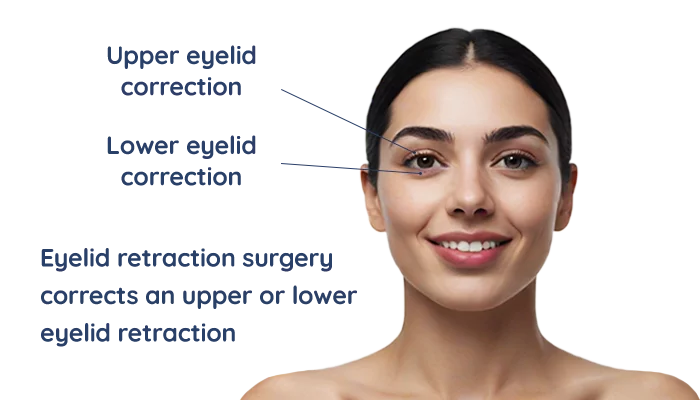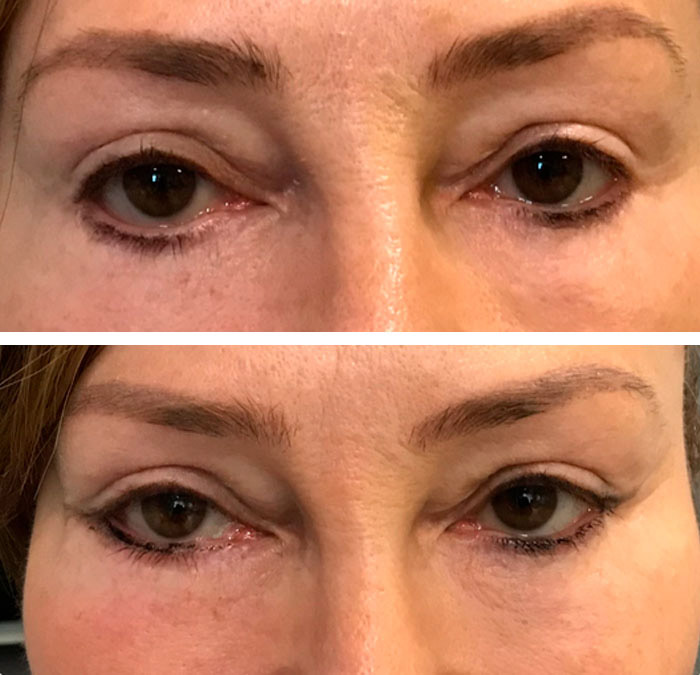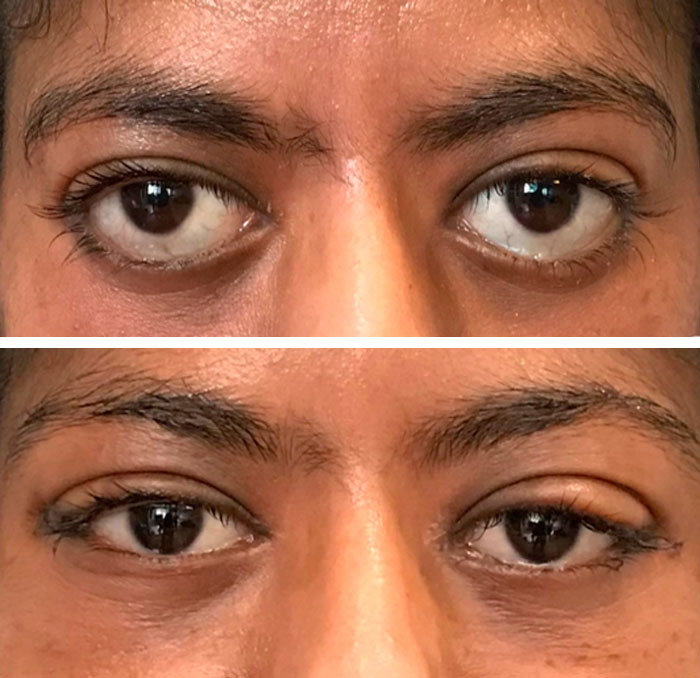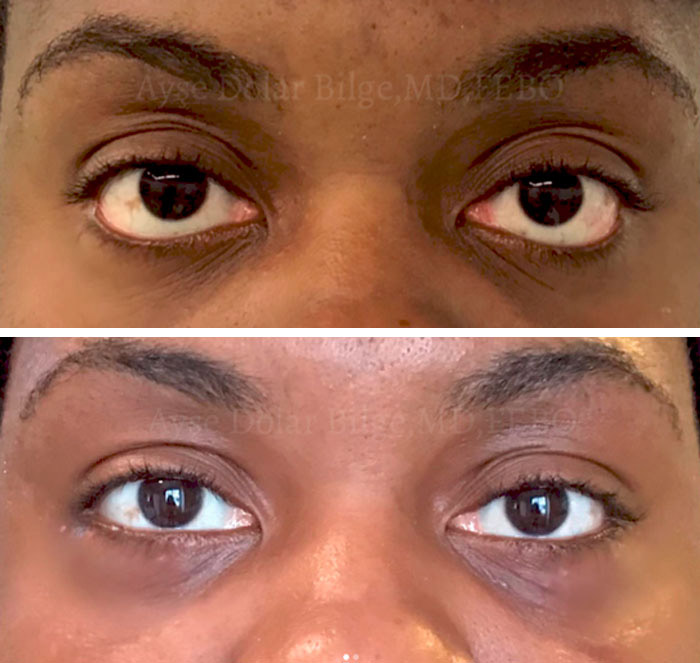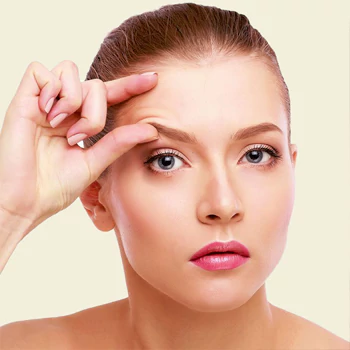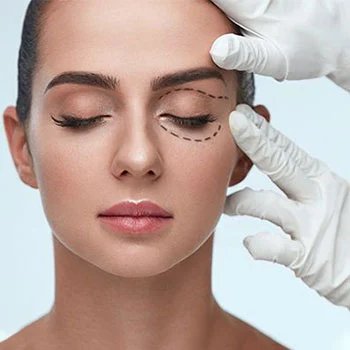What is eyelid retraction?
Eyelid retraction refers to a condition where the upper or lower eyelid is positioned higher or lower than its normal position, respectively, within the eye socket. This can result in an abnormal appearance of the eyelids, with the affected eyelid appearing more open or pulled back compared to the other eyelid. It can lead to symptoms such as dryness, irritation, exposure of the cornea, and even vision problems in severe cases. Treatment for eyelid retraction depends on the underlying cause and may involve medical management, surgical interventions, or a combination of both.
What causes eyelid retraction?
Eyelid retraction can occur due to various factors, and the specific cause often depends on whether it affects the upper or lower eyelid. Here are some common causes of eyelid retraction:
- Thyroid Eye Disease (Graves' Disease): The most common cause of eyelid retraction, particularly upper eyelid retraction, is thyroid eye disease, also known as Graves' disease. This autoimmune disorder affects the thyroid gland and can cause inflammation and swelling of the tissues around the eyes. The inflammation can lead to the muscles that control eyelid movement becoming tight or stiff, resulting in eyelid retraction.
- Scarring or Trauma: Scarring or trauma to the eyelids or surrounding tissues can cause eyelid retraction. This can occur due to surgeries, injuries, burns, or accidents that affect the muscles, nerves, or supporting structures of the eyelids.
- Congenital or Genetic Factors: Some individuals may be born with eyelid retraction due to congenital abnormalities or genetic factors. These factors can affect the development or function of the eyelid muscles or connective tissues, leading to abnormal eyelid positioning.
- Aging and Tissue Changes: As we age, the tissues and muscles around the eyes can change. This can result in weakened support structures and contribute to eyelid retraction, particularly in the lower eyelid.
- Neurological Conditions: Certain neurological conditions, such as stroke, Bell's palsy, or other nerve-related disorders, can affect the muscle control of the eyelids and lead to eyelid retraction.
It's important to note that eyelid retraction can occur in one or both eyes, and the underlying cause may vary from person to person. Proper evaluation and diagnosis by an ophthalmologist or oculoplastic surgeon are essential to determine the specific cause of eyelid retraction and develop an appropriate treatment plan.
Upper vs lower eyelid retraction
Upper eyelid retraction occurs when the upper eyelid is positioned higher than its normal level, exposing more of the eye. Symptoms of upper eyelid retraction may include a visible white sclera (the white part of the eye) above the iris, increased exposure of the cornea, dryness, irritation, and difficulty fully closing the eye.
Lower eyelid retraction occurs when the lower eyelid is positioned lower than its normal level, resulting in a droopy appearance. Symptoms of lower eyelid retraction may include a visible white sclera below the iris, increased exposure of the lower part of the eye, and potential discomfort or irritation.
Eyelid retraction treatment
Treatments for eyelid retraction surgery repair include non-surgical approaches such as lubricating eye drops, eyelid exercises, and temporary measures like adhesive eyelid tapes. Surgical interventions may involve eyelid lengthening surgery, canthoplasty or canthopexy procedures, and other techniques like eyelid tightening or spacer grafts. The specific treatment option depends on the underlying cause and severity of the eyelid retraction, and it is best determined by a qualified ophthalmologist or oculoplastic surgeon after a thorough evaluation. You should consider seeing a doctor for treatment if you are experiencing symptoms of eyelid retraction or if you are concerned about the appearance or function of your eyelids.
Surgical eyelid retraction repair
Surgical eyelid retraction repair is a procedure performed to correct abnormal eyelid retraction. It is typically used when conservative measures have been ineffective or when the eyelid retraction is severe, causing functional or cosmetic concerns. The specific surgical technique used depends on the underlying cause of the eyelid retraction and the severity of the condition.
How is the surgery performed?
Eyelid retraction repair surgery is performed to correct the abnormal positioning of the eyelid and restore its normal function and appearance. Here is a general overview of how eyelid retraction repair surgery is performed:
- Preoperative Evaluation: Before surgery, a thorough evaluation is conducted by an ophthalmologist or oculoplastic surgeon. This includes a comprehensive examination of the eyelids, surrounding tissues, and ocular structures. The surgeon will assess the cause and severity of the eyelid retraction and discuss the surgical options and expected outcomes.
- Anesthesia: The surgery is typically performed under local anesthesia with sedation, although general anesthesia may be used in certain cases. The choice of anesthesia depends on the patient's preference and the surgeon's recommendation.
- Incision Placement: The surgeon will make incisions in strategic locations based on the specific surgical technique chosen. Incisions are typically made along the natural creases or within the eyelid to minimize visible scarring.
- Correction: The surgeon will make adjustments to the retracted eyelid using different surgical techniques depending on the severity and cause of the retraction (see next section).
- Closure and Recovery: After the necessary adjustments and corrections are made, the incisions are meticulously closed using sutures. The surgeon may apply antibiotic ointment or dressings to protect the incision sites. Postoperative care instructions will be provided, and follow-up appointments will be scheduled to monitor healing and address any concerns.
Eyelid retraction surgery techniques
There are several surgical approaches to repair eyelid retraction, and the choice of technique will be determined by the surgeon based on individual factors. Here are some common surgical procedures for eyelid retraction repair:
Eyelid lengthening
This procedure involves surgically lengthening the affected eyelid to reduce the retraction. Various techniques can be used, such as eyelid tissue grafting or the release of scar tissue. These methods aim to restore the natural position of the eyelid by adjusting its length.
Canthoplasty or canthopexy
These procedures involve modifying the outer corner of the eyelids (canthus) to adjust the tension of the eyelids and improve their position. Canthoplasty involves surgically altering the eyelid's attachment to the underlying structures, while canthopexy strengthens and reinforces the existing attachment.
Tarsorrhaphy
Tarsorrhaphy is a procedure that involves partially sewing together the eyelids to reduce the eyelid opening. This helps to protect the cornea, improve lubrication, and alleviate symptoms associated with severe eyelid retraction. It is often used as a temporary measure or in cases where other surgical options are not suitable.
Spacers or grafts
In some cases, spacers or grafts may be used to support the eyelid and improve its positioning. These can be synthetic or natural materials that are surgically implanted to provide additional support or volume to the affected eyelid.
The choice of surgical technique will depend on factors such as the underlying cause, severity of the eyelid retraction, and individual patient considerations. It is important to consult with an ophthalmologist or oculoplastic surgeon who specializes in eyelid surgery. They will evaluate your specific condition, discuss the available surgical options, and recommend the most appropriate approach for your case.
How to prepare for the procedure
Preparing for an eyelid retraction surgery procedure involves several important steps to ensure a smooth and successful operation. Here are some general guidelines to help you prepare:
- Consultation and Evaluation: Schedule a consultation with an ophthalmologist or oculoplastic surgeon who specializes in eyelid surgery. During this appointment, the surgeon will evaluate your specific case, discuss your concerns and expectations, and determine if you are a suitable candidate for eyelid retraction surgery. They will also provide detailed instructions on how to prepare for the procedure.
- Medical Evaluation: Your surgeon may request a preoperative medical evaluation to assess your overall health and identify any potential risks or complications. This may involve blood tests, imaging studies, or consultations with other specialists if needed. It's important to provide your surgeon with a comprehensive medical history, including any medications, allergies, or previous surgeries.
- Medication Adjustments: Follow your surgeon's instructions regarding any medications you are currently taking. This may include adjusting or temporarily discontinuing certain medications such as blood thinners or anti-inflammatory drugs that can increase the risk of bleeding during surgery. It's crucial to inform your surgeon about all the medications, supplements, and herbal remedies you are taking.
- Lifestyle Adjustments: Your surgeon may recommend certain lifestyle adjustments before the surgery. This can include avoiding alcohol, smoking, or exposure to secondhand smoke, as these factors can affect the healing process and increase surgical risks. Maintaining a healthy diet, staying hydrated, and getting adequate rest are also beneficial for optimal healing.
- Preoperative Instructions: Your surgeon will provide you with specific preoperative instructions to follow. These may include fasting for a specific period before surgery, showering with a special antibacterial soap the night before or the morning of the procedure, and refraining from wearing makeup, lotions, or creams on the day of surgery. It's essential to adhere to these instructions to minimize the risk of complications.
- Support and Transportation: Arrange for someone to accompany you to the surgical facility and drive you back home after the procedure. You may experience temporary blurred vision or discomfort, making it unsafe for you to drive immediately after surgery.
- Postoperative Care: Discuss the postoperative care instructions with your surgeon in advance. This may involve using prescribed eye drops or ointments, applying cold compresses to reduce swelling, and avoiding activities that can strain the eyes or compromise the surgical site. Ensure that you have any necessary supplies or medications ready at home before the surgery.
- Follow-Up Appointments: Schedule any necessary follow-up appointments with your surgeon. These appointments are crucial for monitoring your healing progress and addressing any concerns or questions you may have.
Remember to follow all instructions provided by your surgeon and ask any questions or concerns you may have during the preoperative consultation. By properly preparing for the eyelid retraction surgery procedure, you can help ensure a smoother surgical experience and optimize your recovery.
What is the recovery like?
The recovery process after eyelid retraction surgery can vary depending on the specific surgical technique used, the individual patient, and the extent of the procedure. Here is a general overview of what to expect during the recovery period:
- Immediately After Surgery: After the surgery is completed, you will be monitored in a recovery area for a short period. Your eyes may be covered with protective dressings or ointment to keep them lubricated and protected. You may experience some mild discomfort, swelling, and bruising around the surgical site.
- Discharge and Care Instructions: Once you have recovered from the anesthesia and the surgeon determines that it is safe for you to go home, you will be discharged with detailed postoperative care instructions. These instructions may include how to care for your incisions, how to apply prescribed eye drops or ointments, and what activities to avoid during the initial healing phase.
- Swelling and Bruising: Swelling and bruising around the surgical area are common after eyelid retraction surgery. They typically peak within the first few days and gradually subside over the following weeks. Applying cold compresses and keeping your head elevated can help reduce swelling. Your surgeon may recommend using specific eye drops or ointments to aid in the healing process.
- Pain and Discomfort: Some mild pain or discomfort is normal after surgery. Your surgeon may prescribe pain medications or recommend over-the-counter pain relievers to manage any discomfort. It's important to follow the prescribed dosage and consult your surgeon if you have severe or persistent pain.
- Healing of Incisions: The incisions made during the surgery will gradually heal over time. Your surgeon will provide instructions on how to care for the incisions, including keeping them clean and avoiding any activities that may strain or disrupt the healing process.
- Restrictions and Activity Level: Your surgeon will provide specific guidelines on activities to avoid during the recovery period. This may include avoiding strenuous exercise, heavy lifting, and activities that put strain on the eyes or eyelids.
- Follow-Up Appointments: Your surgeon will schedule follow-up appointments to monitor your progress and remove any stitches or sutures if necessary. These appointments allow your surgeon to assess the healing process, address any concerns or complications, and make any adjustments if needed.
- Results: After eyelid retraction surgery, it typically takes several weeks to a few months for the initial swelling and bruising to subside, and for the final results to become apparent. The exact timeline can vary depending on individual factors such as the extent of the surgery, the patient's healing ability, and the specific techniques used.
It's crucial to closely follow your surgeon's postoperative care instructions, attend all scheduled follow-up appointments, and promptly report any unexpected symptoms or concerns. By doing so, you can facilitate a smoother and more successful recovery after eyelid retraction surgery.
What are the risks and side effects?
Like any surgical procedure, eyelid retraction surgery carries certain risks and potential side effects. While complications are relatively rare, it's important to be aware of the possible risks and discuss them with your surgeon before undergoing the procedure. Some potential risks and side effects of eyelid retraction surgery may include:
- Infection: There is a risk of developing an infection at the surgical site. Your surgeon will provide instructions on how to care for the incisions and minimize the risk of infection. If you notice signs of infection such as increased redness, swelling, pain, or discharge, it's important to contact your surgeon.
- Bleeding: Some bleeding may occur during or after the surgery. Your surgeon will take precautions to minimize bleeding, but in rare cases, additional intervention may be required to control it.
- Scarring: While efforts are made to minimize scarring, there is a possibility of visible scarring at the incision sites. Most incisions are strategically placed within natural creases or hidden areas to minimize their visibility.
- Dry Eyes: Eyelid retraction surgery can occasionally lead to temporary or permanent dryness of the eyes. This can result in discomfort, redness, and a gritty sensation. Your surgeon may prescribe lubricating eye drops or ointments to help manage dryness.
- Asymmetry: Achieving perfect symmetry may be challenging, and there is a possibility of slight asymmetry between the treated eyelid and the unaffected eyelid. However, the goal of the surgery is to improve the overall appearance and function of the eyelids.
- Changes in Eyelid Function: In rare cases, eyelid retraction surgery can cause changes in eyelid function, including difficulty closing the eyes fully or incomplete blinking. Your surgeon will carefully assess your case and take steps to minimize these risks.
- Vision Changes: Although uncommon, there is a risk of temporary or, rarely, permanent vision changes following eyelid retraction surgery. It's important to report any significant changes in vision to your surgeon immediately.
- Anesthesia Risks: General anesthesia or local anesthesia with sedation carries its own set of risks. Your anesthesiologist will evaluate your health and discuss the potential risks and side effects associated with anesthesia.
It's important to have a thorough discussion with your surgeon about the potential risks and complications specific to your case. By carefully following your surgeon's preoperative and postoperative instructions and attending all follow-up appointments, you can help minimize the risks and increase the likelihood of a successful outcome. If you experience any unusual or concerning symptoms during the recovery period, it's important to promptly notify your surgeon.
How much does an eyelid retraction repair cost?
The cost of eyelid retraction surgery can vary depending on several factors, including the geographical location, the surgeon's experience and expertise, the complexity of the procedure, the type of anesthesia used, and the specific surgical facility.
In general, eyelid retraction surgery can range in cost from several hundred to several thousand dollars. This cost typically includes the surgeon's fee, anesthesia fees, facility fees, preoperative evaluations, postoperative care, and any necessary follow-up appointments. It's important to inquire about what is included in the total cost and if there are any additional fees or expenses.
Keep in mind that insurance coverage for eyelid retraction surgery may vary. In some cases, if the eyelid retraction is causing functional problems or significantly impacting vision, insurance may cover a portion or all of the procedure. However, if the surgery is primarily for cosmetic purposes, it is less likely to be covered by insurance.
To have a clear understanding of the costs associated with eyelid retraction surgery, it is recommended to schedule a consultation with a qualified surgeon. During the consultation, they can assess your specific case, discuss your goals and expectations, and provide you with a detailed cost estimate.
It's important to prioritize the qualifications and experience of the surgeon rather than solely focusing on cost. Choosing a skilled and reputable surgeon is crucial to achieving safe and successful results.
Frequently asked questions
What will happen if I do not have my lid retraction repaired surgically?
If you decide not to have surgery for eyelid retraction, the condition may persist, potentially causing ongoing cosmetic concerns and functional issues. The eyelid retraction can lead to an asymmetrical appearance, dryness, irritation, and difficulty fully closing the eyes.
Can eyelid retraction be treated without surgery?
While non-surgical treatments can provide some relief and improvement, they are often considered adjunctive measures or temporary solutions. For more severe or persistent cases of eyelid retraction, surgical intervention is often necessary to achieve significant and long-lasting results.
Does eyelid retraction surgery leave scars?
Eyelid retraction surgery can potentially leave scars, but the goal of the surgery is to minimize their visibility as much as possible. Skilled surgeons employ various techniques to ensure incisions are placed in inconspicuous locations, such as within the natural creases of the eyelids or along the inside of the eyelid (transconjunctival approach). These placement strategies help to hide the scars and make them less noticeable.

